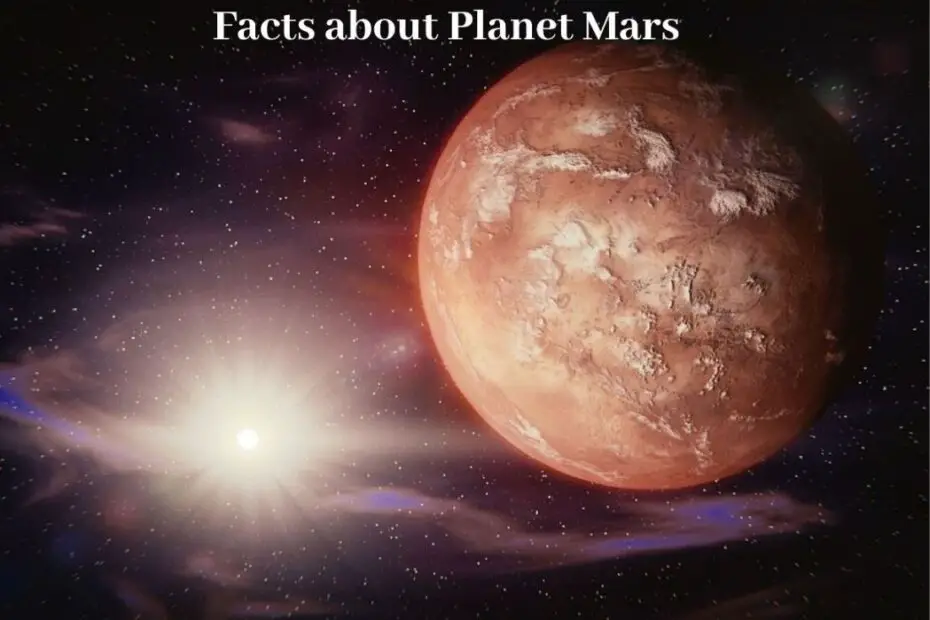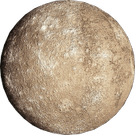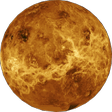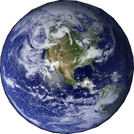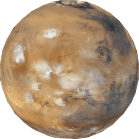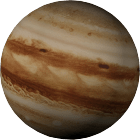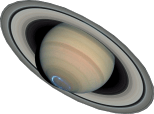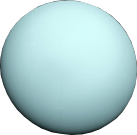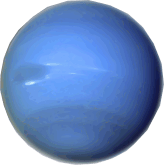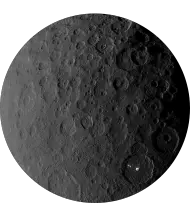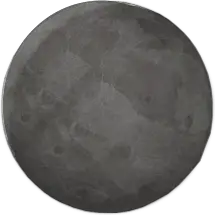Planet Mars is the 2nd smallest planet in our solar system after the planet Mercury. There are a lot of amazing and unique secrets hidden on this small planet. This is the planet, scientists believe most chances of life, and they are searching for life on it. Here we have mentioned many interesting facts about Mars.
Mars is the 4th planet from the sun and 3rd largest terrestrial planet in our solar system. It is named after the Roman God of War and is also known as ‘Red Planet’ because of its reddish appearance.
- A large amount of Iron Oxide is present on the surface of mars giving it a reddish appearance.
Physical characteristics of Mars:
- Orbital period: 687 days (1.9 years)
- Average orbital speed: 24 km/sec around the sun
- Mean radius: 3390 km
- Mass: 6.5 × 1023 kg (10.7% of the earth)
- Mean density: 3.9 gm/cm3
- Surface gravity: 3.7 m/sec2 (37% of the earth)
- Escape velocity: 5.03 km/sec
- Average surface temperature: -63 °C
- Surface pressure: 0.0063 atm (less than 1% of earth)
- Moons: Phobos and Deimos
Unique facts about Mars
Here are some unique and interesting facts about mars have been given:
⇒ Mars has the almost same seasons and days as the earth
The rotational period on its axis of mars is 24 hours 37 minutes. The axial tilt of the rotational axis of mars is 25.19°. Whereas the earth’s rotational period is almost 24 hours and its axial tilt is 23.5°.
Due to such inclination and almost the same rotational period, mars have the same seasons as earth. But every season on mars is longer twice than earth because of its orbital period around the sun. The orbital period of mars is 1.9 times higher than earth.
⇒ The largest dust storm of our solar system on mars
The planet Mars is infamous for its largest dust storm which can cover the entire planet for a few months. Even the intensity of the dust storms can be seen from the earth with a telescope.
In June 2001 Scientists noticed an intense dust storm in the southern hemisphere on Mars. It wrapped the almost whole planet including the northern hemisphere of Mars till July 2001.
On average, in 3 martian years (Mars years= 687 earth days) this dust storm rises on Mars. Though mars have a thin atmosphere still dust storm lasts for a few months.
⇒ Mars has 2 huge polar ice caps like Earth
During the winter season on the poles of Mars, its thin atmosphere gets frozen into layers of CO2 ice. This ice is also called the dry ice of mars. When sunlight falls on the poles, these dry ice converts again into the atmosphere of water vapor and dust.
In the northern winter on the north cap, the dry ice is around 1 meter thick. Whereas the south cap has permanent dry ice and here the thickness of dry ice is around 8 meters.
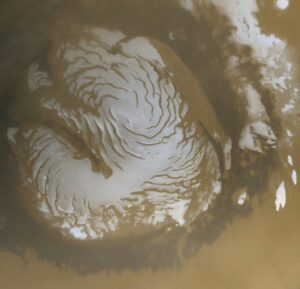
The dry ice of mars directly converts into atmosphere/vapor without converting into a liquid state of water. This direct conversion of the solid to gas phase is called the sublimation process.
- Later these water vapors and dust create a seasonal storm on mars.
⇒ Only the south polar ice cap can cover the entire mars under 11 m depth
The diameter of the south polar cap on mars is 350 km with a thickness of approximately 3 km. It has an estimated 1.6 billion cubic meters of dry ice. According to researchers, this is the sign of unlimited water on mars under the polar caps.
Scientists believe that if the ice of the southern polar cap melts into water, it will cover the entire surface of the planet mars under 11-meter depth (approximately 36 ft).
⇒ Mars is a cold planet
The average temperature on Mars is -63°C. So this is a cold planet. The maximum temperature can reach on mars is 35°C, whereas the minimum temperature on this planet goes up to -143°C.
⇒ Mars is the home of impact craters
Craters are formed due to the hypervelocity impact of smaller bodies on the planetary body. The surface of the mars has more than 600,000 craters. These all craters have a diameter of at least 1 km and most craters have a diameter of 10 km and more.

More than 1000 craters of mars have been assigned a name by IAU. Huygens is the largest crater on Mars, it was named after the Dutch astronomer Christiaan Huygens. The diameter of the Huygens is approximately 467.5 km.
⇒ Largest mountain Olympus Mons
It is a shield volcano with a height of around 22 km and spread in a range of 620 km in diameter. Here one of the unique facts about Mars is given. It is the largest planetary mountain and 2nd tallest mountain in the solar system (if the considered height is 22 km).
(Recently discovered Rheasilvia in Vesta is the tallest known mountain of the solar system with a height of 22.5 km. Vesta is the largest body in the asteroid belts.)
While considering various other sources, the height of Olympus Mons ranges from 21 to 27 km. Olympus Mons is approximately 2.6 times higher than Mount Everest.
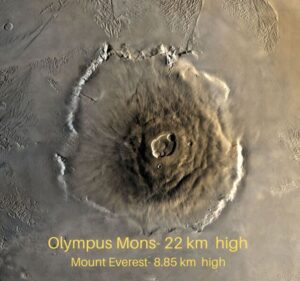
⇒ Methane gas on mars
In 1994 a mission Mars Express (Mars exploration mission) by European Space Agency (ESA) detects methane in the Martian atmosphere. The production of methane happens due to the biological process. So the presence of methane indicates the presence of microbial life on Mars.
The presence of microbial life is a controversial topic among scientists. Because methane can also be produced by some non-biological processes like serpentinization.
⇒ 2 small moons of Mars
Mars has two small moons ‘Phobos and Deimos’ compare to the size of the earth’s moon. The diameter of Phobos is 22 km and it takes 11 hours to complete one revolution. The Deimos is 12 km in diameter and takes 30 hours to complete one revolution.
⇒ Mars will have a ring around it
The gravitational force of mars gradually lowers the orbital distance of the Phobos. The Phobos is coming near to mars and after 30 million years, it will collide with mars. According to the estimation of scientists, the broken part or debris of Phobos will create a ring around it.
⇒ More than 40 missions have been sent to Mars
To study the surface and geology of mars, more than 40 missions have been sent by many of countries. But only 33% of the mission has been successfully completed.
NASA has planned to launch the ‘Mars 2020’ mission in July 2020, whereas the European Space Agency will also launch the ExoMars rover in 2022.
⇒ Future exploration on Mars
Planet Mars is human’s favorite planet to search for life and colonization. Many space agencies are sending spacecraft to explore the planet. And these future explorations are one of the most interesting facts about Mars.
An American aerospace company “SpaceX”, founded in 2002 by Elon Musk, is working for colonization on Planet Mars.
It’s a fact that NASA alone has sent 4 rovers to Mars so far. The four rovers are Sojourner, Spirit (MER-A), Opportunity (MER-B), and Curiosity.
NASA’s Mars Mission 2020 will send a rover on the red planet called Perseverance Rover and it will land in Feb 2021. Tianwen-1(Huoxing-1, HX-1) is a Chinese mission to launch an orbiter, a lander, and a rover on Mars in July 2020. The ExoMars rover (Rosalind Franklin) is planned to launch in 2022 by the European-Russian space agency.
⇒ You can jump 3 times higher on mars
The surface gravity of Mars is only 37% of the earth’s gravity. So if you jump onto the surface of mars you would rise up to 3 times higher compared to the earth. (Know more about the effect of gravity and weight on other planets)
⇒ One of the largest Canyon of the solar system
Valles Marineris is on Mars and it is one of the largest canyons of the solar system. It has a length of approximately 4000 km and a depth of 7 km.
These were some interesting and unique facts about Mars Planet. I hope you have liked reading it. Check the other planet’s interesting and unique facts below.
